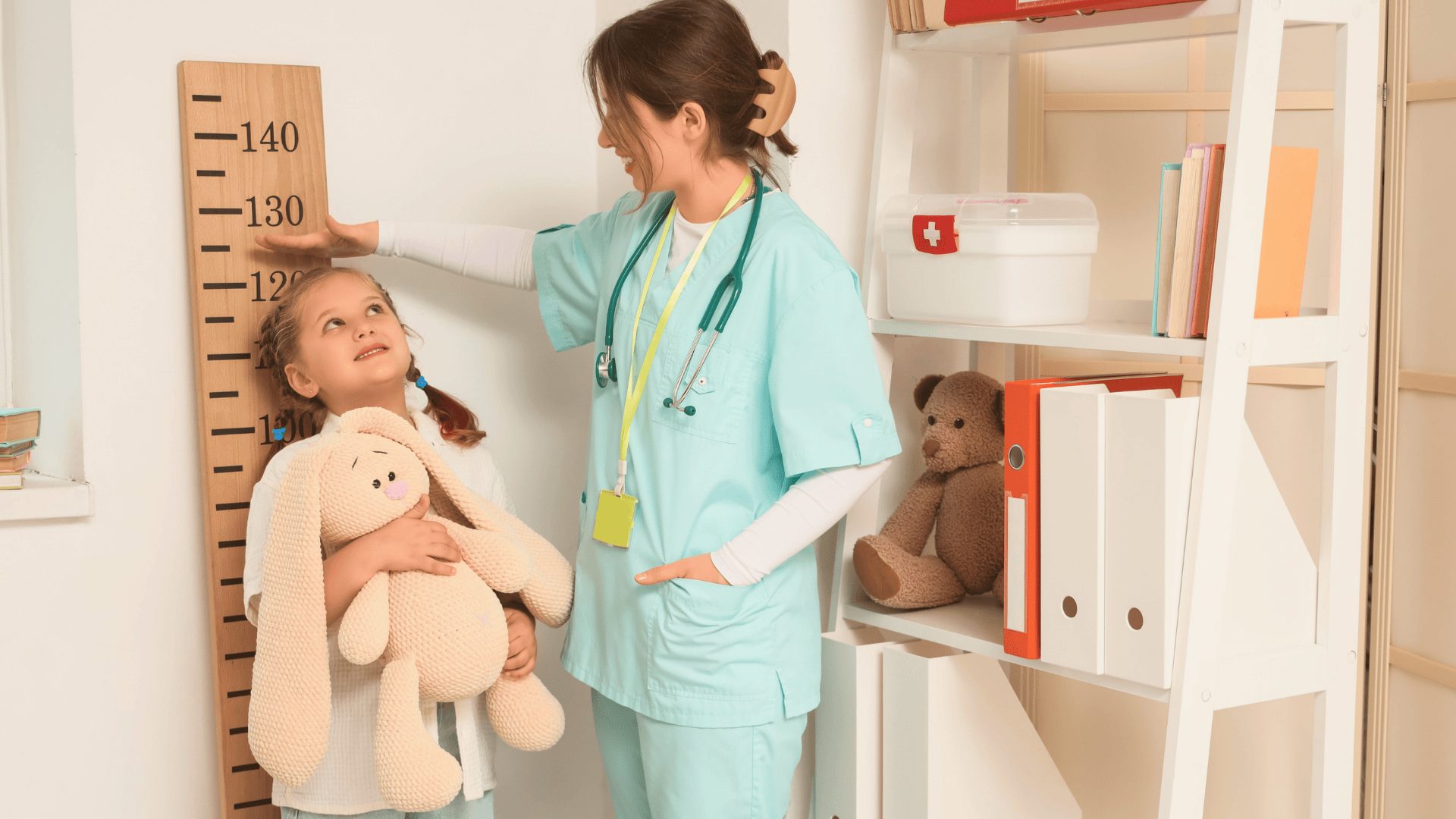Have you ever wondered how often your child should see the doctor for routine visits? These appointments are more than just checkups; they’re the foundation for your child’s long-term health.
I remember how uncertain I felt trying to keep track of all the visits during my child’s first year.
Having a structured well-child check schedule made everything simpler and helped me stay on top of important milestones.
In this blog, you’ll find a complete breakdown of the schedule, covering every age, purpose, and benefit so you can plan confidently and stay prepared.
What Happens During a Well-Child Visit
During a well-child visit, your doctor checks your child’s growth, health, and overall development. These visits help track progress and prevent future problems.
The checkup starts with physical assessments like measuring height, weight, and head size (for babies) to monitor steady growth. The doctor also listens to the heart and lungs and checks posture and reflexes.
Next are developmental and behavioral screenings to observe speech, movement, and emotional health. This helps identify any early developmental or behavioral concerns.
The doctor also discusses daily habits such as eating, sleeping, physical activity, and screen time, offering guidance for healthy routines and safety.
Finally, they review vaccines and milestones, update immunizations, and talk about what new skills your child should be reaching before the next visit.
Well-Child Visit Schedule Overview
Regular well-child visits are an important part of keeping your child healthy and growing on track. These checkups help doctors monitor development, discuss habits, and prevent issues before they start.
1. Infancy (Birth-12 Months)

Babies grow and change quickly during their first year, so regular checkups are important. Most happen at newborn, 1, 2, 4, 6, 9, and 12 months.
Each visit focuses on growth, feeding, sleep, and vaccines. Your pediatrician will check your baby’s weight, height, head size, and developmental milestones while guiding you through feeding and sleep routines.
2. Toddler Years (15-30 Months)

Toddlers are busy finding and learning, so visits continue at 15, 18, 24, and 30 months. These checkups track your child’s progress in language, movement, and social skills.
Your doctor will also discuss behavior, nutrition, and safety at home. Vaccines are updated during this stage to protect against preventable illnesses.
3. Early Childhood (3-5 Years)

From age 3, children start having annual visits instead of every few months. These appointments cover school readiness, healthy routines, and emotional growth.
Your pediatrician will also review vaccine boosters, vision, and hearing tests to ensure your child is ready for preschool and kindergarten.
4. Middle Childhood (6-10 Years)

At this stage, yearly checkups focus on steady growth, learning progress, and physical activity. The doctor will assess height, weight, posture, and general health habits.
It’s also a good time to talk about nutrition, sleep, and screen time to support healthy routines during the school years.
5. Preteens and Teens (11-21 Years)

Older kids and teens continue with yearly visits that focus on both physical and emotional health. Doctors monitor puberty, mental well-being, and peer relationships.
Vaccines such as Tdap, HPV, and meningococcal are usually given during this stage. Around age 18, your child begins transitioning from pediatric to adult healthcare.
Special Considerations
Some children may need a slightly different well-child visit schedule based on their health and growth patterns.
- Preterm infants: Babies born early often follow an adjusted schedule based on their corrected age. This helps track growth and milestones accurately since they may reach developmental stages later than full-term babies.
- Missed visits: If a checkup or vaccine appointment is missed, doctors create a catch-up plan. This ensures your child stays up to date on growth checks, developmental screenings, and immunizations.
- Chronic health conditions or special needs: Children with ongoing medical concerns, developmental delays, or special care requirements may need more frequent visits. These appointments focus on progress tracking, therapy updates, and coordinated care with specialists.
- Rapid growth or weight concerns: If your child is growing faster or slower than expected, extra visits may be scheduled to monitor nutrition, diet, and overall growth patterns more closely.
- Family or environmental factors: In families experiencing major changes, like moving, stress, or limited access to healthcare, additional visits may help ensure your child’s emotional and physical well-being stays on track.
Recommended Well-Child Visit Schedule and Vaccine Guide
Here’s a simple guide to help parents track when well-child visits happen, what they include, and which vaccines are typically given.
| Age Range | Visit Purpose | Key Screenings | Common Vaccines |
|---|---|---|---|
| Newborn (First week) | Check weight, feeding, and newborn health | Jaundice, hearing, and newborn reflexes | Hepatitis B (first dose) |
| 1–2 Months | Growth and feeding check | Vision tracking, muscle tone | Hepatitis B (second dose) |
| 4 Months | Monitor growth, sleep, and early milestones | Head control, movement | DTaP, Hib, Polio, Pneumococcal, Rotavirus |
| 6 Months | Nutrition and development review | Sitting, social response | DTaP, Hib, Polio, Pneumococcal, Rotavirus, Flu |
| 9 Months | Crawling, eating habits, and sleep | Developmental and hearing screening | Catch-up doses if needed |
| 12 Months | Walking, speech, and behavior | Lead and anemia screening | MMR, Varicella, Hepatitis A, Hib, Pneumococcal |
| 15–18 Months | Growing independence and safety | Language and social skills | DTaP booster, Hepatitis A (second dose) |
| 2–3 Years | Development and potty training | Vision and behavior screening | Catch-up vaccines if needed |
| 4–5 Years | School readiness | Vision, hearing, fine motor skills | DTaP, Polio, MMR, Varicella boosters |
| 6–10 Years | Learning, nutrition, and physical activity | Growth and BMI tracking | Annual Flu shot |
| 11–12 Years | Puberty and preventive health | Scoliosis, emotional health | Tdap, HPV (start series), Meningococcal |
| 13–17 Years | Mental health, school, and sports | Depression, substance use | HPV (finish series), Meningococcal booster, Flu |
| 18–21 Years | Transition to adult care | Routine labs and wellness checks | Annual Flu, catch-up or booster vaccines |
Conclusion
A well-child check schedule helps you stay on top of your child’s health, growth, and development. Each visit builds on the last, ensuring your child gets the right care at the right time.
These appointments aren’t just about vaccines or measurements; they’re a chance to ask questions, track milestones, and catch any concerns early.
They give parents peace of mind and doctors a full picture of a child’s progress.
Now’s a good time to check when your child’s next visit is scheduled. Mark it on your calendar and keep the momentum going toward lifelong health and well-being.
Frequently Asked Questions
How can I prepare my child for a well-child visit?
You can make visits easier by explaining what will happen in simple, reassuring terms. Bring a favorite toy or blanket for comfort, and stay calm so your child feels relaxed.
Are well-child visits covered by insurance?
Most insurance plans, including Medicaid, cover well-child visits and vaccines as part of preventive care. Still, it’s smart to confirm details with your provider before booking.
What if my child is sick on the day of the visit?
If your child has a mild cold, the appointment can usually continue. For fever or contagious illness, call your pediatrician to see if rescheduling is best.
Do I need to bring anything to the appointment?
Yes, bring your child’s vaccination record, a list of any medicines they take, and questions you’d like to discuss. This helps the doctor address everything in one visit.










